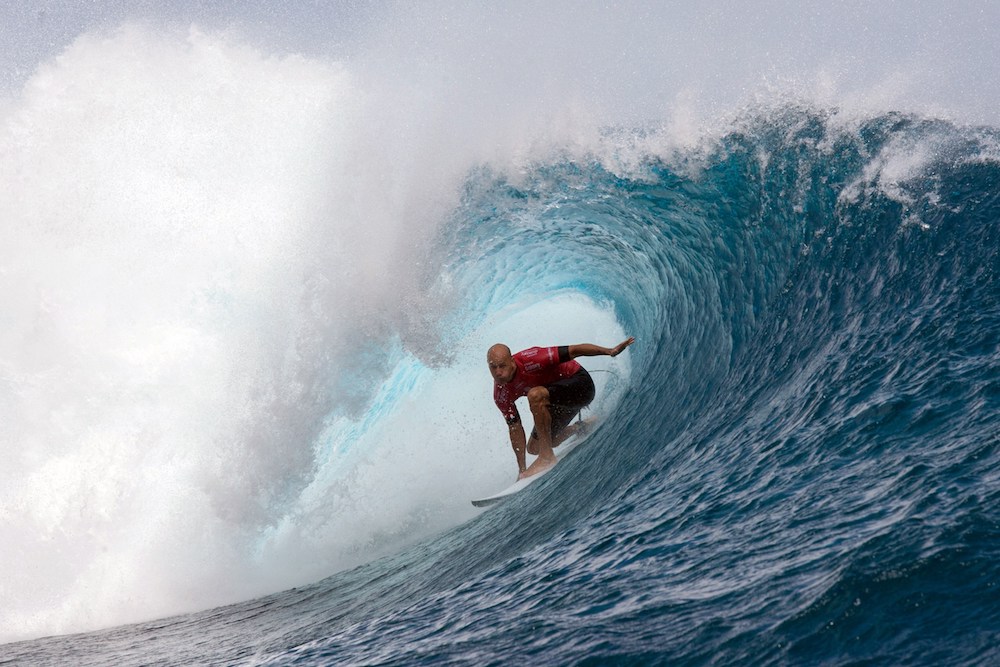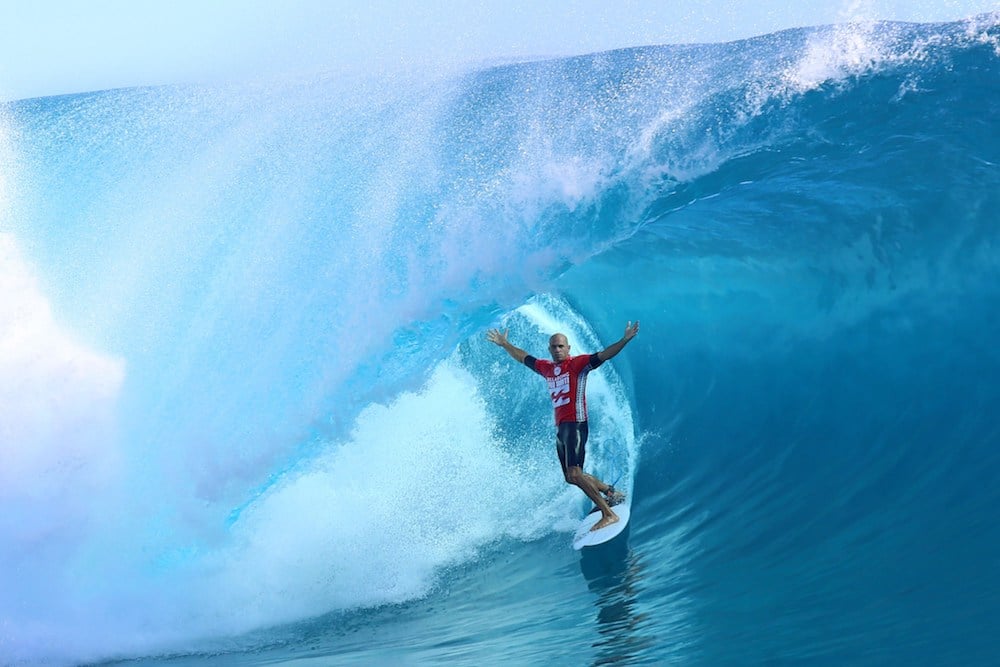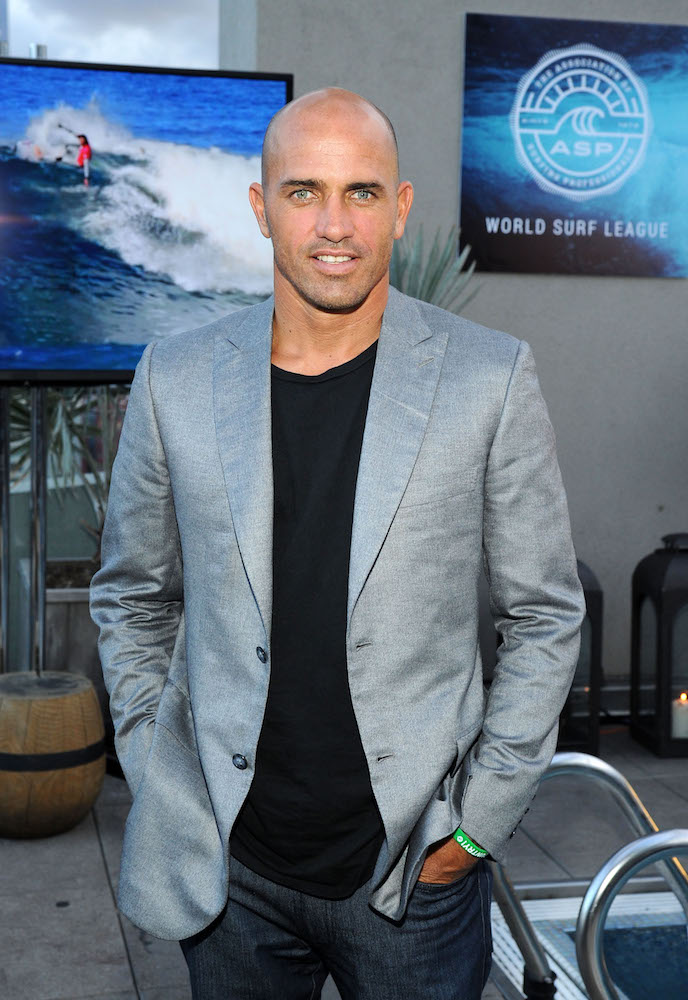Kelly Slater, the World’s Greatest Surfer, Has Plans to Blow Your Mind Even More
The most accomplished surfer on the planet is creating a suite of global brands based on sustainability and imagination.

In the predawn chill of December 5, 2015, Kelly Slater pulled on his wetsuit, grabbed his board, and dove into the water. Although Slater, an 11-time World Champion surfer, had taken a similar predawn plunge countless times before, this morning was different.
With onlookers that included fellow World Surf League pros Nat Young and women’s champion Carissa Moore, the 44 year old paddled out and caught a wave that may turn out to have been the most groundbreaking ride of his life. Carving up and down the face with the smooth slashes of a fencer’s blade, Slater dipped into the wave’s barrel. There, crouched in what surfers call the “green room,” Slater rode for what seemed like an eternity.
As he emerged from the tube, he triumphantly threw up his arms while the crowd cheered, because this was no ordinary wave. Slater wasn’t in the Pacific Ocean but rather 110 miles inland, on a man-made lake in California’s San Joaquin Valley. And the wave wasn’t a product of Mother Nature but of Slater himself. Through the Kelly Slater Wave Company (KSWC), the surfer and entrepreneur has spearheaded a decade-long quest to build the perfect artificial wave. He had a vision of bringing surfing to landlocked states and countries and, in doing so, revolutionizing the sport. “I’ve been waiting for this moment since 2005,” he said in a video posted that December. “This is the best man-made wave ever made.”
Vision has always been an integral part of Slater’s success. Growing up in Cocoa Beach, Florida, he and his older brother, Sean, with whom he surfed, did not have the luxury of big West Coast swells. That meant making the most of smaller surf, seeing something—a spot for an aerial, a chance for one last cutback— where others saw little.
At 18, Slater turned professional and quickly won his first pro contest, the Body Glove Surf Bout, at Lower Trestles in California. He signed a six-figure deal with Quiksilver. Two years later, he claimed his first World Championship, the youngest surfer in history to do so. Slater mania was born. He was a regular on Baywatch and dated celebrities like Pamela Anderson and Gisele Bündchen. He modeled underwear for Versace and opened for Pearl Jam with his own band, the Surfers.
All the while Slater kept winning, including five consecutive World Championships from 1994 to 1998. He possessed extraordinary talent and indefatigable hunger, but what really separated him from the rest was his inventiveness. Surfing, at its core, is as much art as sport. Greatness requires improvisation and pushing limits à la Miles Davis or Pablo Picasso, and no one was more imaginative than the kid from Florida.

Then Slater retired, only to return to the WSL Tour (formerly called the Association of Surfing Professionals) in 2003 and eventually win five more titles, the most recent in 2011. In an interview, the surfing magazine Stab asked him to describe himself in clinical terms. Slater replied, half-joking: “Obsessive-compulsive disorder mixed with a little borderline addictive personality disorder when it comes to things he loves.”
While his love of surfing hasn’t waned, he shouldn’t, theoretically, still be competing. The average age of the rest of WSL’s top 10 surfers is 26.3, and Slater is nearly twice as old as 24-year-old points leader John John Florence. Yet on August 23, there was the senior citizen of pro surfing beating Florence in the final of the Billabong Pro Tahiti. With his showing at Teahupo’o, one of the most powerful breaks in the world, Slater earned his 55th elite tour win, further cementing his legacy.
For the past few years, however, the greatest surfer of all time has sought more than great waves. “He’s trying to do some good in the world,” says Pete Johnson, an Oahu, Hawaii, native who’s been friends with Slater for 30 years. “He’s passionate about other things and aspires to be a better man.” Slater is a voracious reader, whether the subject is business, nutrition, or cancer, the disease that took his father in 2002. He’s hands-on with the Kelly Slater Foundation, which has supported the fight against cystic fibrosis and melanoma. He’s become more conscientious, making sure to take time to call friends going through hard times. He’s expanding his horizons. Evolving. “I strive to be better and better in all aspects of my life and to learn as much as I can about the things that interest me,” Slater tells Maxim.

Two of Slater’s most recent interests have been developed with the same vision he first brought to Cocoa Beach. In 2014, he broke ties with Quiksilver after 23 years to form his own clothing line, Outerknown. Employing the talents of designer and fellow surfer John Moore, founder of the acclaimed surf lifestyle label M.Nii, and Julie Gilhart, the former fashion director of Barneys New York, Slater sought to create a brand that was surfer chic as opposed to beach bro. Outerknown launched in July 2015, and Slater has insisted on couture with a conscience.
“I wanted to create an independent, socially compliant supply chain and use environmentally friendly textiles and materials,” Slater explains, pointing out the label’s use of organic cotton and hemp, regenerated Italian wool, and recycled fishing nets. Describing Outerknown, he uses words like integrity, transparency, and sustainability. “Sustainability comes from the materials that go into making the clothes and workplace conditions being up to scratch,” he says. “The things behind the scenes were as important to me as the end product.”
Slater is a co-owner of Firewire Surfboards, and this year the company launched, for the first time, a set of boards of his own design. Like Outerknown, Firewire focuses on sustainability, and it’s the first global manufacturer to have every board it makes qualify for Sustainable Surf ’s Ecoboard certification. “In the past couple of years I’ve been taking a bigger interest in things I’m involved with,” Slater says. “Board design is a natural thing for me anyway, and I never stop working on it, so it was natural to start something that was right in my wheelhouse.”
” tml-render-layout=”inline
As for his other passion project, KSWC, the possibilities are staggering. No longer beholden to geography and unreliable ocean swells, the sport could potentially explode—training centers across the globe, surfers able to refine their skills 365 days a year. Instead of golf, resorts could offer guests the chance to catch a wave. The KSWC wave could help the industry’s dream of making surfing an Olympic sport become a reality.
Yet like Slater himself, the wave project is a work in progress. “It didn’t disappoint,” says Johnson, who at Slater’s behest surfed the KSWC wave three months ago. “But Kelly’s always seeking to improve it.” While at the San Joaquin Valley property, Slater constantly tested variable power levels, fiddled with different speeds, and took copious notes.
Perfection may take a while, but the world’s greatest surfer isn’t complaining. “It’s great to start out big and fast if you can sustain that,” he says. “But you get the last laugh if you work out how to have the longevity you’d imagine you can have with a fresh mind and a healthy approach.”
For more, pick up the December/January issue of Maxim, and be sure to subscribe so you never miss an issue.
